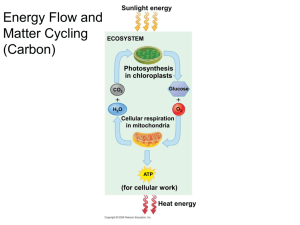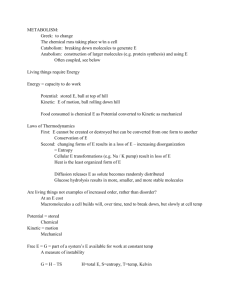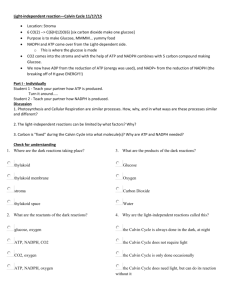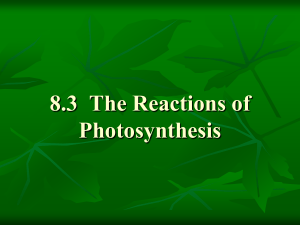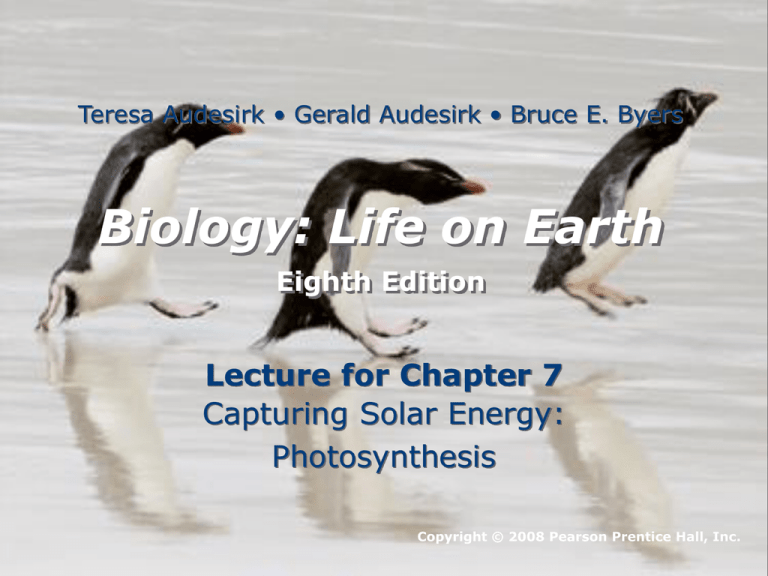
Teresa Audesirk • Gerald Audesirk • Bruce E. Byers
Biology: Life on Earth
Eighth Edition
Lecture for Chapter 7
Capturing Solar Energy:
Photosynthesis
Copyright © 2008 Pearson Prentice Hall, Inc.
evolution.berkeley.edu/.../images/chicxulub.gif
The ability to capture sunlight energy and
convert it to chemical energy.
iStockphoto.com/hougaardmalan
6CO2 + 6H2O + light energy C6H12O6 + 6O2
carbon water
dioxide
sunlight
glucose
(sugar)
oxygen
Plants, algae, and some prokaryotes
Are autotrophs (“self- feeders”)
uni-bielefeld.de
Are interconnected
Water, CO2, sugar, and O2 are used or
produced as byproducts in both processes
Leaves
Chloroplasts
Flattened leaf shape exposes large surface area
to catch sunlight
Epidermis
upper and lower leaf surfaces
Cuticle
waxy, waterproof outer surface
reduces water evaporation
Stomata
Mesophyll
adjustable pores allow for entry of air with CO2
inner cell layers that contain majority of chloroplasts
Vascular bundles (veins)
supply water and minerals to the leaf while carrying
sugars away from the leaf
Chloroplasts
Stroma
bounded by a double membrane composed of inner
and outer membranes
semi-fluid medium within the inner membrane
Thylakoids
disk-shaped sacs found within the stroma
in stacks called grana
2 sets of chemical
reactions occur in the:
1.
Thylakoid membranes
2.
Stroma
Pigment molecules (e.g. chlorophyll) of the
thylakoids capture sunlight energy
Sunlight energy is converted to the energy
carrier molecules ATP and NADPH
Oxygen is released as a by-product
Enzymes in stroma synthesize glucose
and other organic molecules using the
chemical energy stored in ATP and
NADPH
What two energy carrying molecules are used
to store captured sunlight energy during lightdependent reactions?
Sun radiates electromagnetic energy
Photons (basic unit of light)
packets of energy with different energy levels
short-wavelength photons are very energetic
longer-wavelength photons have lower
energies
Visible light is radiation falling between
400-750 nanometers of wavelength
Light Captured by Pigments
Absorption of certain wavelengths
light is “trapped”
Reflection of certain wavelengths
light bounces back
Transmission of certain wavelengths
light passes through
Absorbed light drives biological processes when it is
converted to chemical energy
Pigment absorbs visible light
Common pigments:
Chlorophyll a and b
absorb violet, blue, and red light but reflect green light (hence
they appear green)
Carotenoids
absorb blue and green light but reflect yellow, orange, or red
(hence they appear yellow-orange)
Are accessory pigments
autumn-pictures.com
Photosystems within thylakoids
Assemblies of proteins, chlorophyll, &
accessory pigments
Two Photosystems
PSII (comes 1st) and PSI (comes 2nd)
Each Photosystem is associated with a
chain of electron carriers
Steps of the light reactions:
1.
Accessory pigments in Photosystems absorb light and
pass energy to reaction centers containing chlorophyll
2.
Reaction centers receive energized electrons…
3.
Energized electrons then passed down a series of
electron carrier molecules (Electron Transport Chain)
4.
Energy released from passed electrons used to
synthesize ATP from ADP and phosphate
5.
Energized electrons also used to make NADPH from
(NADP+) + (H+)
Electrons from PSII flow one-way into PS I
PSII – produces ATP
PSI – produces NADPH
May be used by plant or released into
atmosphere
NADPH and ATP from light-dependent rxns
used to power glucose synthesis
Light not directly necessary for lightindependent rxns if ATP & NADPH available
Light-independent rxns called the CalvinBenson Cycle or C3 Cycle
6 CO2 molecules used to synthesize 1 glucose
(C6H12O6)
CO2 is captured and linked to ribulose
bisphosphate (RuBP)
ATP and NADPH from light dependent rxns
used to power C3 reactions
“Photo”
“Synthesis”
capture of light energy (light dependent rxns)
glucose synthesis (light-independent rxns)
Light dependent rxns produce ATP and NADPH
which is used to drive light-independent rxns
Depleted carriers (ADP and NADP+) return to lightdependent rxns for recharging
The ideal leaf:
Large surface area
to intercept
sunlight
lowcarboneconomy.com
biology-blog.com
Very porous to
allow for CO2
entry from air
forestry.about.com
sbs.utexas.edu
Problem:
Substantial leaf porosity leads to substantial water
evaporation, causing dehydration stress on the plant
Plants evolved waterproof coating and
adjustable pores (stomata) for CO2 entry
When stomata close, CO2 levels drop and O2 levels
rise
Photorespiration occurs
Carbon fixing enzyme combines O2 instead of CO2 with
RuBP
Photorespiration:
O2 is used up as CO2 is generated
No useful cellular energy made
No glucose produced
Photorespiration is unproductive and
wasteful
Hot, dry weather causes stomata to stay closed
O2 levels rise as CO levels fall inside leaf
Photorespiration very common under such
conditions
Plants may die from lack of glucose synthesis
weedtwister.com
“C4 plants” have chloroplasts in bundle sheath
cells and mesophyll cells
Bundle sheath cells surround vascular
bundles deep within mesophyll
C3 plants lack bundle sheath cell
chloroplasts
C4 plants utilize the C4 pathway
Two-stage carbon fixation pathway
Takes CO2 to chloroplasts in bundle
sheath cells
C4 pathway uses up more energy than C3
pathway
C3 plants thrive where water is abundant or if light
levels are low (cool, wet, and cloudy climates)
Ex. : most trees, wheat, oats, rice, Kentucky
bluegrass
C4 plants thrive when light is abundant but water is
scarce (deserts and hot climates)
Ex. : corn, sugarcane, sorghum, crabgrass, some
thistles


